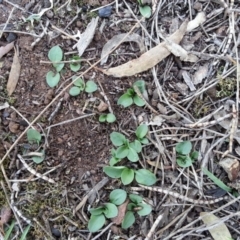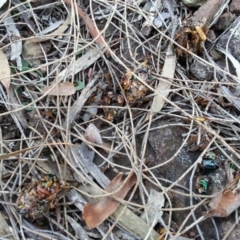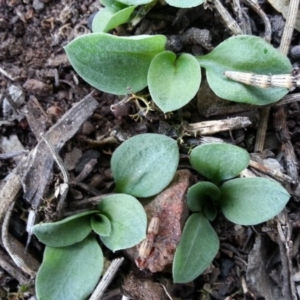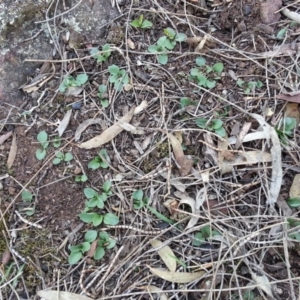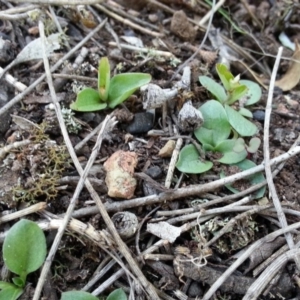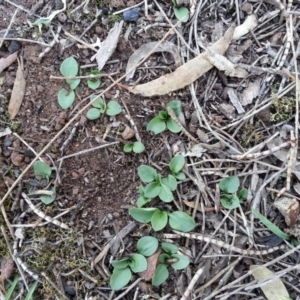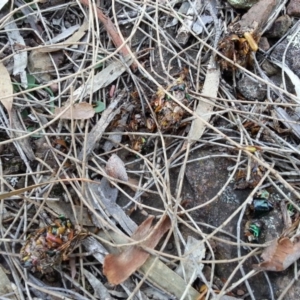1 Little Dumpies, Brittle Greenhood at Canberra Central, ACT
Identification history
| Diplodium truncatum | 3 May 2017 | TonyWood | ||
| Diplodium truncatum | 3 May 2017 | waltraud |
Identify this sighting
Please Login or Register to identify this sighting.
User's notes
Petersan recorded one flowering Diplodium truncatum at this site (http://canberra.naturemapr.org/Community/Sighting/3376562) which was decapitated when he revisited. When Peter and I visited the site this morning we put a wire mesh on top of the approximately 60 rosettes that occur within about 1square meter. 2 specimen appeared to have been grazed (see 3rd photograph top) and there was a bit of digging around. Checking the Field guide to the orchids of the ACT, Jones et al (2008) I found that the rosettes seem to fit the description of Diplodium truncatum. We noticed pellets probably from a Pied Currawong (5th photograph). Wonder whether a Currawong would mistake a flower for some kind of invertebrate or other interesting food matter?
31 comments
AaronClausen
wrote:
4 May 2017
Love it, brilliant work guys!!! This is a really decent looking colony...
AaronClausen
wrote:
4 May 2017
Given this discovery, there are a pile of other leaves that MattM discovered which could also be this same species, but we've never seem them in flower to be able to confirm. I'll try to dig up the sighting..
AaronClausen
wrote:
4 May 2017
Maybe you should send Petersan a PM Matt.. If your leaves were confirmed to be Little Dumpies, I'm throwing a Dumpy party!
waltraud
wrote:
4 May 2017
A colony of Slaty helmet orchids near by but those have a single basal leave which seems more rounded.
TonyWood
wrote:
4 May 2017
Yes they definitely look like rosettes of D. truncatum. I have seen very large colonies of D. truncatum that produce rosettes every year but only occasionally produce flowers.Choughs can be the culprit for scratching out tubers. The flowers of Diplodiun are sometimes grazed by Macropods.
AaronClausen
wrote:
4 May 2017
I wish I wasn't getting smashed by work as I would love to come to this one Matt. Maybe Mt Majura has lots of Little Dumpies then, so we need to monitor annually. I went up to MattM's colony a few weeks ago, but couldn't even find the leaves that used to be there?
waltraud
wrote:
4 May 2017
Yes, there are a lot of Swamp wallabies around there...
i just drafted an email to petersan reg id of similar looking Diplodium rosettes which i copy in below
"I checked rosette leaf id features of Diplodium truncatum and D. revolutum at PlantNet (the basal rosette of these 2 species look very similar, at least to me)
D. trunctum D. revolutum
basal leaves: 2-6 3-7
ovate to lanceolate ovate
length: 1-3.5cm 1-3cm
width: 5-17mm 4-12mm
On the photos that I took I could not see a single specimen with 7 leaves; in fact I could not see one with more than 5 leaves - this does not exclude D. revolutum.
I saw a few with only 2 leaves which would point to D. truncatum (unless 3rd leaf was eaten).
If I go up again i would take measurements, if there are leaves wider than 12mm they are D. truncatum.
I'm not sure how likely it would be that there is a mixed colony of both species - perhaps very unlikely. So the flowering specimen is most likely the best hint."
cheers to all :)
i just drafted an email to petersan reg id of similar looking Diplodium rosettes which i copy in below
"I checked rosette leaf id features of Diplodium truncatum and D. revolutum at PlantNet (the basal rosette of these 2 species look very similar, at least to me)
D. trunctum D. revolutum
basal leaves: 2-6 3-7
ovate to lanceolate ovate
length: 1-3.5cm 1-3cm
width: 5-17mm 4-12mm
On the photos that I took I could not see a single specimen with 7 leaves; in fact I could not see one with more than 5 leaves - this does not exclude D. revolutum.
I saw a few with only 2 leaves which would point to D. truncatum (unless 3rd leaf was eaten).
If I go up again i would take measurements, if there are leaves wider than 12mm they are D. truncatum.
I'm not sure how likely it would be that there is a mixed colony of both species - perhaps very unlikely. So the flowering specimen is most likely the best hint."
cheers to all :)
petersan
wrote:
4 May 2017
Matt, I would be available tomorrow afternoon and would meet up with you if you like. Otherwise, if I have the GPS I could go an have a look at the other site.
waltraud
wrote:
4 May 2017
Peter, you could borrow one of my Garmin GPS if you like - I have trades people tomorrow (morning) thus can't make it to the mountain.I could also give you the pegs described in email to you.
cheers
cheers
petersan
wrote:
4 May 2017
Hi Waltraud, I meant if I had the coordinates. The iPhone works OK so I would not nee date Garmin
Peter
Peter
AaronClausen
wrote:
4 May 2017
Matt it would be TOPS to compare Peter's leaves with the ones you found near your helmets.!!
MattM
wrote:
4 May 2017
Aaron, I thought these were the ones near the helmets. Regardless, I am heading over tomorrow.
AaronClausen
wrote:
4 May 2017
Ugh - yep I think you're right, sorry I didn't look closely enough. Ok I'm keen for your report tomorrow, SMS update please :)
waltraud
wrote:
4 May 2017
Peter Matt
I have trades persons today however depending on the time you head up to the mountain I may be able and would love to join you. I'll send phone contact to peter's email.
I have trades persons today however depending on the time you head up to the mountain I may be able and would love to join you. I'll send phone contact to peter's email.
petersan
wrote:
4 May 2017
I can't make it this morning unfortunately (dentist) but look forward to hear what Matt discovers.
waltraud
wrote:
4 May 2017
Matt, I have a date with trades persons at 9.30am at my place so unfortunately I can't join you.
waltraud
wrote:
4 May 2017
Matt
We put a red marker tape low on a stem of an Acacia close to the dumpies colony and a wire mesh on top. It should be not too difficult to find the colony if you have the coordinates.
We put a red marker tape low on a stem of an Acacia close to the dumpies colony and a wire mesh on top. It should be not too difficult to find the colony if you have the coordinates.
MattM
wrote:
4 May 2017
Can you message them to me? I don't have access to them as I don't have moderator permissions.
MattM
wrote:
4 May 2017
Yeah. I found them. I have known they were here for 3 years now, just never knew the species.
waltraud
wrote:
5 May 2017
Matt, what do you think? you saw the dumpies colony today that peter & i covered.
i can provide special pegs and more flat wire mesh sheets to protect other colonies. however I'm pressed with time right now. W
i can provide special pegs and more flat wire mesh sheets to protect other colonies. however I'm pressed with time right now. W
MattM
wrote:
5 May 2017
I wouldn't know a thing about caging them. I have seen the pockets there over the past few years, but they don't seem to have declined over the years, so I would assume it's more a waster of time to cover them all.
petersan
wrote:
5 May 2017
But they were not seen in flower before - so caging may have been useful in the past? Should it be assumed now that they are all the same truncatum and left to nature?
waltraud
wrote:
5 May 2017
hm
perhaps a bit of caging won't hurt considering the reports of digging and grazing. I'm happy to provide anything needed. Caging could have a negative impact on orchids though if things grow too dense as it seems for the CPR fences on Mt Majura to protect the Canberra Spider orchids. Checks would be necessary, in other words, Peter would you consider to become a custodian? envisage some caged orchid colonies to be checked from time to time; if all to much give a yell and cages will be removed. Just an idea.
perhaps a bit of caging won't hurt considering the reports of digging and grazing. I'm happy to provide anything needed. Caging could have a negative impact on orchids though if things grow too dense as it seems for the CPR fences on Mt Majura to protect the Canberra Spider orchids. Checks would be necessary, in other words, Peter would you consider to become a custodian? envisage some caged orchid colonies to be checked from time to time; if all to much give a yell and cages will be removed. Just an idea.
TonyWood
wrote:
5 May 2017
ok I'll put in my bit here. Caging should be viewed as a temporary measure during the active growing period when flowers are starting to appear. If left permanently the vegetation doesn't get grazed and the orchids have to compete with other vegetation. The Diplodium have just about finished their flowering, what you are seeing are the rosettes of non-flowering plants, Caging now might help in deterring choughs and the like scratching out the tubers, but the time to cage is probably late Summer / early Autumn when the flowers and new rosettes start to appear.
petersan
wrote:
5 May 2017
Tony, The interesting thing here is that the rosettes are in a thin layer of 3-5cm of soil over solid rock. There is no other vegetation in the area where the rosettes appear. There is however grazing by birds. If the important thing is to know the species, which we now do, and the species through rosettes can and do survive (have for 3 years) irrespective of whether they flower or not, then caging does not seem warranted unless there is value in protecting any flowers that do appear (maybe it is the flower that attracts the grazer?). So based on TonyWood's comment it would seem best to remove the cage in a couple of weeks and keep an eye on the site next year to monitor the rosettes and any flowering that may occur. I could do that if it is agreed.
The other site I found the flowers are wedged in Wallaby grass and I saw no sign of rosettes around them. Completely different environment.
The other site I found the flowers are wedged in Wallaby grass and I saw no sign of rosettes around them. Completely different environment.
Location information
- Maps Mount Majura
- Places Canberra Central, ACT
Sighting information
- 16 - 100 Abundance
- 3 May 2017 09:13 AM Recorded on
- waltraud Recorded by
Additional information
- Less than 10cm Plant height
Species information
- Diplodium truncatum Scientific name
- Little Dumpies, Brittle Greenhood Common name
- Sensitive
- Rare or uncommon native
- Non-Invasive
- 168 images trained Machine learning
-
In flower
- External link More information
-
Synonyms
Pterostylis truncata
Record quality
- Overall Fit for scientific/research use
- Images or audio
- More than one media file
- Confirmed by an expert moderator
- Nearby sighting(s) of same species
- GPS evidence of location
- Description
- Additional attributes



